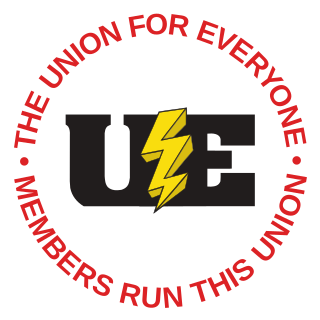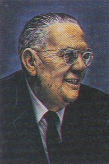The State, County, and Municipal Workers of America (SCMWA) was an American labor union representing state, county, and local government employees. It was created by the Congress of Industrial Organizations (CIO) in 1937 along with United Federal Workers of America. SCMWA's leaders Abram Flaxer and Henry Wenning had been leaders of the Association of Workers of Public Relief Agencies (AWPRA) in New York City prior to the formation of SCMWA.
Through informal negotiations in 1935, AWPRA persuaded the New York City Emergency Relief Board (ERB) to adopt a personnel policy that permitted union representation and granted due process protections against discipline including notice, an opportunity to be heard, and the right to appeal to a neutral board. In cases of general staff reductions, the policy all granted the right to hearing to determine allegations of discrimination because of race, creed. union activity or membership in any special group. The personnel policy was later extended to the entire New York City Welfare Department.
SCMWA is sometimes confused with the American Federation of State, County and Municipal Employees (AFSCME). AFSCME was an affiliate of the American Federation of Labor, and SCMWA was formed following the creation of the CIO. At the time SCMWA was created in 1937, its policies, principles, and tactics were aimed at the establishment of appropriate negotiation procedures and the development of cooperative relationships with employers. As part of its initial policies, SCMWA rejected the use of strikes and picketing; that policy changed a few years later.
SCMWA was active in many states, organizing state and local government workers decades before the enactment of public sector collective bargaining laws. SCMWA negotiated collective bargaining agreements with local public employers that provided for exclusive representation and prohibited discrimination. In 1943, SCMWA negotiated the first collective bargaining agreement for school district teachers and staff with the Board of Education of Gloucester City, New Jersey. It also negotiated some of the first contracts in higher education in the 1940s.
In 1946, the CIO merged SCMWA with United Federal Workers of America to form the United Public Workers of America (UPWA). In 1950, UPWA was purged from the CIO along with other radical unions.
History
In 1937, a number of AFSCME local unions, composed primarily of caseworkers, disaffiliated from that union and joined the Congress of Industrial Organizations (CIO). [1] The CIO allowed these local unions to form the State, County, and Municipal Workers of America, and charged the new organization with competing with AFSCME at the state and local levels for membership. [2] Most of the leaders and many of the members of these local unions were strongly sympathetic to the beliefs and goals of the Communist Party USA. [1] [3] Former AFSCME executive board member Abram Flaxer was appointed the new union's president, and former AFSCME Secretary-Treasurer David Kanes held the same post in SCMWA. [1] SCMWA membership grew quickly: It more than doubled the number of local unions (from 12 to 28) in a year, [4] and its members rose from 25,000 in 1937 to more than 48,000 in 1946. [2] [5] [6] In comparison, AFSCME's membership grew from 13,259 in 1937 to more than 73,000 in 1946. [7]
On April 25, 1946, SCMWA merged with the United Federal Workers of America (UFWA) to form the United Public Workers of America. [8] [9] [10] The impetus for the merger was the relative failure of the UFWA to attract new members, and SCMWA essentially absorbed the smaller federal union. [11]

The National Labor Relations Act of 1935 is a foundational statute of United States labor law that guarantees the right of private sector employees to organize into trade unions, engage in collective bargaining, and take collective action such as strikes. Central to the act was a ban on company unions. The act was written by Senator Robert F. Wagner, passed by the 74th United States Congress, and signed into law by President Franklin D. Roosevelt.

The Labor Management Relations Act of 1947, better known as the Taft–Hartley Act, is a United States federal law that restricts the activities and power of labor unions. It was enacted by the 80th United States Congress over the veto of President Harry S. Truman, becoming law on June 23, 1947.
Collective bargaining is a process of negotiation between employers and a group of employees aimed at agreements to regulate working salaries, working conditions, benefits, and other aspects of workers' compensation and rights for workers. The interests of the employees are commonly presented by representatives of a trade union to which the employees belong. The collective agreements reached by these negotiations usually set out wage scales, working hours, training, health and safety, overtime, grievance mechanisms, and rights to participate in workplace or company affairs.
In the context of labor law in the United States, the term "right-to-work laws" refers to state laws that prohibit union security agreements between employers and labor unions. Under these laws, employees in unionized workplaces are banned from negotiating contracts which require employees who are not union members to contribute to the costs of union representation. Right-to-work laws do not aim to provide general guarantee of employment to people seeking work.
In labor law, a union shop, also known as a post-entry closed shop, is a form of a union security clause. Under this, the employer agrees to either only hire labor union members or to require that any new employees who are not already union members become members within a certain amount of time. Use of the union shop varies widely from nation to nation, depending on the level of protection given trade unions in general.
Jerome Wurf was a U.S. labor leader and president of the American Federation of State, County and Municipal Employees (AFSCME) from 1964 to 1981. Wurf was a friend of Martin Luther King Jr., and was arrested multiple times for his activism, notably during the Memphis sanitation strike. He was present for King's "I've Been to the Mountaintop" oratory at the strike, the day before King was assassinated, and attended King's funeral.
A union security agreement is a contractual agreement, usually part of a union collective bargaining agreement, in which an employer and a trade or labor union agree on the extent to which the union may compel employees to join the union, and/or whether the employer will collect dues, fees, and assessments on behalf of the union.

The United Electrical, Radio and Machine Workers of America (UE), is an independent democratic rank-and-file labor union representing workers in both the private and public sectors across the United States.
In the United States Senate, the La Follette Civil Liberties Committee, or more formally, Committee on Education and Labor, Subcommittee Investigating Violations of Free Speech and the Rights of Labor (1936-1941), began as an inquiry into a National Labor Relations Board (NLRB) investigation of methods used by employers in certain industries to avoid collective bargaining with unions.

George W. Taylor was a notable professor of industrial relations at the Wharton School at the University of Pennsylvania, and is credited with founding the academic field of study known as industrial relations. He served in several capacities in the federal government, most notably as a mediator and arbitrator. During his career, Taylor settled more than 2,000 strikes.

The American Federation of State, County and Municipal Employees (AFSCME) is the largest trade union of public employees in the United States. It represents 1.3 million public sector employees and retirees, including health care workers, corrections officers, sanitation workers, police officers, firefighters, and childcare providers. Founded in Madison, Wisconsin, in 1932, AFSCME is part of the AFL–CIO, one of the two main labor federations in the United States. AFSCME has had four presidents since its founding.
George Hardy was a Canadian-American labor leader who was president of the Service Employees International Union (SEIU) from 1971 to 1980. At the time of his death, SEIU had grown to become the fifth-largest affiliate of the AFL-CIO. Hardy was a vice president of the AFL-CIO from 1972 to 1980, and a member of its executive council. He was a former member of the Democratic National Committee and the California Democratic State Central Committee.
The United Public Workers of America (1946–1952) was an American labor union representing federal, state, county, and local government employees. The union challenged the constitutionality of the Hatch Act of 1939, which prohibited federal executive branch employees from engaging in politics. In United Public Workers of America v. Mitchell, 330 U.S. 75 (1947), the Supreme Court of the United States upheld the Hatch Act, finding that its infringement on the Constitutional rights was outweighed by the need to end political corruption. The union's leadership was Communist, and in a famous purge the union was ejected from its parent trade union federation, the Congress of Industrial Organizations, in 1950.
The United Federal Workers of America (UFWA) was an American labor union representing federal government employees which existed from 1937 to 1946. It was the first union with this jurisdiction established by the Congress of Industrial Organizations. In 1946 it merged with other unions to form the influential United Public Workers of America. The union challenged the constitutionality of the Hatch Act of 1939, which led to the Supreme Court decision in United Public Workers v. Mitchell, 330 U.S. 75 (1947).
Railway Labor Executives' Association (RLEA) was a federation of rail transport labor unions in the United States and Canada. It was founded in 1926 with the purpose of acting as a legislative lobbying and policy advisory body. At times, it played a prominent role in setting rail transport policy in the U.S., and was party to six U.S. Supreme Court cases. It disbanded in January 1997, with representation, collective bargaining, and legislative lobbying assumed by the newly formed Rail Division of the AFL-CIO Transportation Trades Department.
Executive Order 10988 is a United States presidential executive order issued by President John F. Kennedy on January 17, 1962 that recognized the right of federal employees to collective bargaining. This executive order was a breakthrough for public sector workers, who were not protected under the 1935 Wagner Act.

The Congress of Industrial Organizations (CIO) was a federation of unions that organized workers in industrial unions in the United States and Canada from 1935 to 1955. Originally created in 1935 as a committee within the American Federation of Labor (AFL) by John L. Lewis, a member of the United Mine Workers (UMW), and called the Committee for Industrial Organization, its name was changed in 1938 when it broke away from the American Federation of Labor. It also changed names because it was not successful with organizing unskilled workers within the AFL.
Harris v. Quinn, 573 U.S. 616 (2014), is a US labor law case of the United States Supreme Court regarding provisions of Illinois state law that allowed a union security agreement. Since the Taft-Hartley Act of 1947 prohibited the closed shop, states could still choose whether to allow unions to collect fees from non-union members since the collective agreements with the employer would still benefit non-union members. The Court decided 5–4 that Illinois's Public Labor Relations Act, which permitted the union security agreements, violated the First Amendment. A similar case was decided in 2018 called Janus v AFSCME.
Abram Flaxer (1904-1989) was an American union leader who founded the State, County, and Municipal Workers of America (SCMWA), which merged with the United Federal Workers of America (UFWA) to form the United Federal Workers of America (UFWA), of which he became president.
The United Office and Professional Workers of America (UOPWA) (1937–1950) was a CIO-affiliated union and one of the white-collar unions formed by the CPUSA-breakaway party of Lovestoneites.




